The concept of polyculture of fish is based on the concept of total utilization of different trophic and spatial niches of a pond in order to obtain maximum fish production per unit area. Different compatible species of fish of different trophic and spatial niches are raised together in the same pond to utilize all sorts of natural food available in the pond.
In general, undrainable pond is characterized by its diversified spatio-trophic environment comprising of various natural fish food organisms (Phytoplankton, Zooplankton, Periphyton, Macrophytes, Benthos and detritus) at different strata of pond water column as well as in the bottom. Selection of species in polyculture is thus very important. There should be a compatible combination of species with diversified feeding habit that should include planktivorous surface/column feeders to benthic/detritivorous bottom feeders as well as omnivorous to macrovegetation feeding fish species.
The possibilities of increasing fish production per unit area, through polyculture, is considerable, when compared with monoculture system of fish. Different species combination in polyculture system effectively contribute also to improve the pond environment. Algal blooming is common in most tropical manure fed ponds. By stocking phytoplanktophagus Silver carp in appropriate density certain algal blooming can be controlled. Grass carp on the other hand keeps the macrophyte abundance under control due to its macrovegetation feeding habit and it adds increased amount of partially digested excreta which becomes the feed for the bottom dweller coprofagous common carp. The bottom dwelling mrigal, common/mirror carp help re-suspension of bottom nutrients to water while stirring the bottom mud in search of food. Such an exercise of bottom dwellers also aerates the bottom sediment. All these facts suggest that polyculture is the most suitable proposition for fish culture in undrainable tropical ponds.
Considering the level of management in fish production, the following culture practices can be identified.
Under this culture practice, no nutritional inputs (manure and feed) are applied to the pond. Fish solely depends on the natural feed available in a pond and hence the carrying capacity of a pond remain low, resulting in lower fish production.
Salient features are :
Semi-intensive culture is primarily a manure based culture practice where supplementary feeding is avoided or of very limited use. Carrying capacity of pond is higher than that of extensive culture and ensures higher production of fish.
Salient features are :
Under intensive culture practice total nutritional requirements of fish are satisfied with the application of high quality formulated, pellet feed. In addition, replenishment, aeration and/or recirculation of pond water is carried out in order to maintain oxygen rich, good quality water capable of high production per unit area of culture.
Salient features are :
Polyculture of three indigenous carps - catla, rui and mrigal is traditional in Bangladesh. However, the culture system depends primarily on natural productivity of the pond. Manuring and feeding are either irregular or not practiced at all. All these suggest that the practice of fish culture in Bangladesh is more or less extensive type or at best at semi-intensive level. As a result, the average yield is very low, around 1000 kg/ha/year. The farmers are keeping fish in ponds rather than doing fish culture in ponds. Though the inputs (manure, feed etc.) required for semi-intensive culture are locally available, the rural farmers are not trained to take advantage of the opportunities. On the other hand large scale introduction of intensive management of fish production at this moment does not seem to be a practical proposition. The intermediate technology of semi-intensive method of fish production using cheap and locally available manure and feed seems to be the appropriate technology for Bangladesh.
Management of fish culture in ponds include successive stages starting from pond preparation to final harvesting of fish. The total package of pond management practices can be divided into three phases viz. pre-stocking management, stocking management and post-stocking management.
This is actually the pond preparation phase which includes renovation of pond, eradication of undesirable fishes and aquatic weeds, liming of pond bottom and base manuring of pond.
Characteristics of ideal fish pond and renovation of existing ponds
A pond of any size can be considered fit for fish culture. Although, a grow-out pond of 2–5 bigha that retains at least 2 m water round the year is found to be suitable for production of carps. The overall environmental conditions suitable for fish production are better in larger ponds than that of smaller ponds.
The bottom soil of an ideal pond should be loamy to clay-loamy. Such soil is best for fish pond because of its good water retention capacity, rich fertility that supports production of natural food organisms and lower turbidity.
The pond dyke should be free from large trees to facilitate maximum light fall and wind action. Sun light and wind action are very important factors for maintaining biological productivity of fish ponds. Ideally, the pond should have well built high dykes all around to protect the pond from flooding, to prevent entry of predators and weed fishes, and to prevent stocked fish from escaping.
Improvement of pond environment
Environment of a pond has direct impact on fish production. A pond with suitable environmental features would give higher fish production per unit area than that of a pond having adverse environmental conditions.
All the aquatic vegetations (floating, submerged or emergent) should be removed from the pond. They hamper primary productivity by absorbing available nutrients from water and soil and hinder normal penetration of sun light and wind action. The large trees on the dykes and their overhanging branches also adversely affect the pond environment by casting shadow and falling leaves, fruits etc. into water. All such trees and their branches should be trimmed.
The pond bottom should be made even to allow effective netting and harvesting of fish. The broken pond dyke must be repaired and well raised so that in and outward migration of fish can be avoided under normal flooding situation. Grass or other vegetables can be planted on the dykes which would help prevent erosion of dyke in monsoon months and alleviate turbidity problem as well. The Rodents are also one of the causes of dyke erosion as they make holes in the dyke. They are to be killed by traps and the holes are to be properly blocked.
Eradication of undesirable fishes
All the predatory and unwanted fishes must be eradicated from the pond prior to stocking the pond with the fingerlings of desirable species. This can be done either by complete dewatering the pond or by poisoning. Some commonly used efficient fish toxicants are mentioned here:
Rotenone
Rotenone kills all the fish species except shrimps when applied @ 2–3 ppm. The killed fish is also suitable for human consumption. However, higher cost and unavailability are the negative points. Toxicity lasts for about 10 – 12 days.
Phostoxin
This is a kind of fumigant poison found in tablet form specially prepared for control of storage pests. Active ingredient is Aluminum phosphide (57%). Phostoxin has been found very effective in killing all sorts of fish @0.2 ppm. Toxicity lasts for around 10–15 days. The killed fish is also suitable for consumption.
Tea seed cake
In tea seed cake the active ingredient responsible for killing the fish is the Saponin. Tea seed cake is effective at 75–100 ppm. (5 – 10 ppm Saponin content). Before application, the tea seed cake should be soaked overnight and then broadcast over the pond surface. The toxicity lasts for about 10–12 days and the killed fish is fit for human consumption. In Sylhet and Chittagong area tea seed cake is readily available.
Mahua oil cake
Mahua (Basia latifolia) oil cake contains 4–6% Saponin and kill fishes when applied @ 250 ppm. The toxicity lasts for about 10–15 days under normal conditions. Killed fish is fit for human consumption. It also serves as a base manure in the pond.
Bleaching Powder
Bleaching powder, as fish toxicant has been found to kill fishes within 3–4 hours when applied @ 30 ppm. Its toxicity lasts for about 7–8 days in the pond. Killed fish is not fit for human consumption. It kills all sorts of biota in the pond. Repeated use may cause the reduction of pond productivity. This chemical has an excellent disinfecting effect besides oxidizing the decomposing matter on the pond bottom.
For calculation of actual quantity of poison required for a pond from the above mentioned concentration the following formula can be used :


Liming
Liming of a fish pond is highly recommended because of its following advantages:
Lime neutralizes soil acidity and creates a buffer system to prevent marked diurnal fluctuations of the water from acidic to alkaline conditions.
Destroys fish pathogens and their intermediate life stages;
Converts unsuitable acidic condition of water to suitable alkaline condition;
Neutralizes iron compounds which are undesirable in fish ponds;
Promotes mineralization of soil which is desirable in fish ponds;
Settle excess dissolved organic matters and thereby reduces incidences of oxygen depletion;
Acts as disinfectant and improves hygienic condition of pond.
Apart from other advantages, the buffering action of calcium is the most important. Lime serves both the prophylactic and therapeutic purposes. Lime treatment for ponds should be done before initial manuring as given in Table-2.1.
Table 2.1 Quantity of lime to be applied in accordance with soil type
| Soil pH | Soil type | Quantity of lime (CaCO3)(kg/bigha) |
| 4.0–4.9 | Highly acidic | 270 |
| 5.0–6.4 | Moderately acidic | 140 |
| 6.5–7.4 | Near neutral | 70 |
| 7.5–8.4 | Mildly alkaline | 30 |
| 8.5–9.5 | Highly alkaline | No liming |
Source : Kumar (Manuscript)
For treating the pond bottom after dewatering, the quick lime [CaO] is the best. Application of quick lime @30–40 kg per bigha also disinfects the pond to some extent. For water treatment only the slacked lime [Ca(OH)2] should be used instead of calcium oxide.
Manuring
In undrainable ponds where the frequent change of water is a remote possibility the physio-chemical properties of pond water governing the biological production cycle are more or less a reflection of the bottom soil. In semi-intensive fish culture, considerable quantities of nutrient elements are removed from the pond ecosystem through fish production. Therefore, the fertilizer requirement vary depending on soil productivity levels (Table 2.2).
Table 2.2 Amount of fertilizers required for ponds at high, medium and low levels of productivity
| Pond productivity levels / rate of application (kg/bigha/yr) | High | Medium | Low | |
| Organic carbon (C) | Cattle dung | 700–1000 | 1100–1400 | 1400–3400 |
| Nitrogen(N) | *Nitrogen requirement | 13–20 | 20–27 | 27–33 |
| Urea (43–45%) | 15–20 | 21–30 | 30–35 | |
| Phosphate (P2O5 | *Phosphate requirement | 7–10 | 10–13 | 13–17 |
| Triple super phosphate (40–45%) | 7–10 | 10–15 | 15–20 | |
Source : Kumar (Manuscript).
Organic manuring, besides being important as a means of adding the nutrients in water is also equally important for improving the soil texture. If there is shortage of organic manures, the application of inorganic fertilizers is recommended. A generalized schedule can be adopted in the absence of detailed soil and water analysis data (Table 2.3).
Table 2.3 Generalized fertilization schedule
| Item | Quantity (kg/bigha) |
| Base manuring (Pre-stocking) | |
| 1. Chicken manure (dry) | 250 |
| (or) | |
| Cow dung | 400 |
| 2. Urea | 10 |
| 3. Triple Super Phosphate (TSP) | 5 |
| Regular (Post stocking) | |
| Daily | |
| 1. Chicken manure | |
a. dry without rice husk | 5–10 |
b. dry with rice husk | 12–17 |
c. fresh pure | 10–12 |
| (or) Cow dung fresh | 15–20 |
| 2. Urea | 0.1 kg |
| 3. TSP | 0.05 kg |
The proper mode and timing of application of fertilizers are very important in order to get good results as well as avoid water quality problems. Manures/ fertilizers should be applied only when the other environmental conditions of water are suitable such as sunshine, good oxygen content and adequate water level etc. The best way of applying is to dissolve the fertilizers in water and spray throughout the pond surface. The best time for manuring is morning within 9–10 o'clock. Application of manure/fertilizer in late afternoon or evening may cause oxygen depletion in the early hours of the following day because of faster decomposition at night. During fully cloudy and rainy days, manuring has to be suspended. In case of algal blooming the manuring/fertilization has also to be lessened or stopped.
Manure and fertilizers are best utilized when the desired total dose is given in small portions. Daily manuring with small quantity has been found best for keeping optimum level of fish food organisms in pond throughout the fish production period. For example, the best utilized manure is from the animals reared together with fish under the integrated livestock-cum-fish culture system.
Water regulation
The average water depth in a pond is an important factor in fish culture. This, generally, depends on various factors like rainfall, evaporation losses, seepage, use of water for irrigation, etc. If necessary, water may be let in from nearby available sources during summer or drained out during monsoon to maintain desirable water depth in the pond. Heavy accumulation of metabolites at the bottom of ponds may deplete oxygen in the pond water during low water depths, adversely affecting fish growth. However, such problems generally not occur in seasonal ponds.
Procurement, transportation and stocking of quality fingerlings of different compatible species of fish in ponds are the activities to be undertaken under stocking management phase.
Species selection
Judicious selection of compatible fast growing species is of vital importance in maximizing fish production. A combination of six species, viz. Catla (Catla catla), Silver carp (Hypophthalmichthys molitrix), Rui (Labeo rohita), Grass carp (Ctenopharyngodon idella), Mrigal (Cirrhinus mrigala), and Common carp (Cyprinus carpio) fulfills the species selection requirement and has proven to be ideal combination for freshwater carp culture in Bangladesh. Of these, Catla and Silver carp are surface feeders, Rui is a column feeder, Grass carp is a macrovegetation feeder and Mrigal and Common carp are bottom feeders. The six species combinations have been found to yield maximum production and are generally preferable in the region. These species are the “back bone” of polyculture. Some supplementary species may also be introduced. Thai sarputi (Puntius gonionotus) is very popular and can be used in a polyculture system. A list of compatible species with their spatio-trophic habits is given in Table-2.4.
Table 2.4. Compatible carp species for polyculture with their spatio-trophic habits.
| Species | Spatio-trophic habits |
| Silver carp (Hypophthalmichthys molitrix) | Surface feeder - Phytoplanktophagous |
| Bighead carp (Aristichthys nobilis) | Surface feeder - Zooplankton feeder |
| Catla (Catla catla) | Surface feeder - Zooplankton form the major diet |
| Grass carp (Ctenopharyngodon idella) | Surface/column feeder - Macrophyte feeder |
| Rui (Labeo rohita) | Predominantly column feeder - plankton and organic debris form the major diet |
| Thai Sarputi (Puntius gonionotus) | Column/bottom feeder - Plankton and soft aquatic weeds form the major diet |
| Mrigal (Cirrhinus mrigala) | Bottom feeder - Detritivore |
| Common/Mirror carp (Cyprinus spp.) | Bottom feeder - Omnivore |
Stocking density
Rate of stocking generally depends on the biological productivity of a pond and the amount of supplementary feeding. In general, stocking rate is determined in relation to water surface area of a pond. A pond having an average water depth of 2.5 m may be stocked at the rate of 700–900 fingerlings/bigha.
Species ratio
Selection of species ratio generally depends on seed availability, market demand, nutrient status of a pond etc.
The following general guidelines are found to be very useful :
Six species culture system
Under six species combination the system surface feeders should form about 40–50% (catla 10–15%, silver carp 30–35%); column feeder (rui) 20–25% in moderately deep ponds (above 2 m average water depth), and 10% in shallow ponds (below 2 m average water depth); bottom feeders 30–40% (mrigal 15–20% and common carp 15–20%) and macrovegetation feeder (grass carp) 5–10% depending upon the availability of a dependable source of weed supply.
Five species culture system
In the absence of dependable source of feed for grass carp five species combination may be adopted wherein Silver carp, Catla, Rui, Mrigal, Common and Mirror carp may form 20–30%, 10–15%, 15–20%, 10–15% and 15–20% respectively.
Four species culture system
Although silver carp grows faster and contribute significantly to the total production, due to lower price and market demand in some areas it is not a preferred species. Under such condition four species combination may be followed consisting of Catla 30–40%, Rui 20–30% in deeper ponds and 10–15% in shallower ponds, Mrigal 15–20% and common carp 15–20%.
Three species culture system
Depending upon the market demand, price and availability of quality seed, even a three species combination system consisting of 3 indigenous carp species may be followed (Catla 40%, Rui 30%, and Mrigal or Common carp 30%).
Generally all the fish species should be stocked at a time. However, it has been observed that due to some degree of inter-specific competition for food between catla and silver carp the growth of catla is affected. As such, it is recommended that silver carp should be stocked one or two months later than catla, by the time catla generally picks up good growth rate. Silver carp with its faster growth rate is able to attain over 1 kg size in 9–10 months.
It is advisable to stock the ponds with larger fingerlings of 10–15 cm size for better survival. Recent experiments have, however, indicated the possibility of high survival and production rates when stocked with early fingerlings (5–8 cm) in predator free ponds. The other advantage of using smaller size (5–8 cm) is the cheaper price.
This phase includes the activities to be undertaken from stocking of fingerlings up to the final harvesting of fish from the pond. The activities are - manuring, feeding, growth and health monitoring, water quality monitoring, hazard management, partial harvesting - restocking and final harvesting.
Manuring
Besides, application of high dose of base manuring before stocking, regular addition of manure in small quantity is required in semi-intensive culture system in order to ensure uninterrupted propagation of natural fish food organisms in the pond.
Poultry manure or cow dung is the cheapest available source of organic manure for fish pond in rural Bangladesh. It has been observed that daily application of 8– 12 kg manure (chicken/cow-dung) in an one bigha pond is sufficient for maintaining optimum level of biological productivity in a pond throughout the culture period. However, in some ponds, it may be necessary to add some inorganic fertilizers along with the organic manure. Addition of 0.7–1.0 kg urea and 0.35– 0.5 kg TSP per bigha per week have been found good for ponds with higher density of phytoplankton feeding silver carp.
Supplementary feeding
The need for supplementary feeding in a polyculture pond depends on the intensity of fish culture. After certain level of fish biomass increase, the available natural food organisms in a pond are not sufficient to support further growth of fish. In Bangladesh, the prepared balanced fish feed are not yet. Oil cakes, rice/wheat brans, grain fodders, other agricultural by-products and available slaughter house by-products (blood, rumen content, viscera etc.) may be utilized as fish feed ingredients (Table 2.5).
Table - 2.5 Chemical composition of generally available ingredients for fish feed (As % of dry matter)
| Chemical components | Rice bran | Broken rice | Wheat bran | Mustard oil cake | Fish meal | Fresh blood | Poultry viscera |
| Dry matter | 91.3 | 88.6 | 90.7 | 90.0 | 86.0 | 20.2 | 26.3 |
| Crude protein | 13.7 | 8.5 | 13.9 | 39.0 | 55.6 | 95.7 | 52.9 |
| Crude lipid | 5.4 | 0.6 | 8.3 | 11.0 | 12.0 | 0.2 | 42.4 |
| Nitrogen free extract | 48.8 | 90.2 | 60.1 | 28.0 | 8.2 | - | - |
| Crude fiber | 20.0 | 0.2 | 13.1 | 12.0 | 2.9 | - | - |
| Others | 12.1 | 0.5 | 4.6 | 10.0 | 21.3 | 4.1 | 4.7 |
| Digestible energy Kcal/kg | 2416 | 3077 | 2995 | 3108 | 3569 | 36562 | 5508 |
Source: New, 1987.
Besides natural aquatic weeds in ponds, the grass carp can be fed with cut bits of soft fodder grass like napier grass and tender leaves (Fig.2.1). The best growth rate can be achieved, if fresh green feed is supplied @ 30–50% of the estimated body weight per day. The green feed should be applied inside floating frame tied to a bamboo pole so that the consumption by the fish could easily be monitored. The grass carp also eat other supplementary feed. It is more aggressive than other species. The grass carp should therefore be fed about half an hour before the application of supplementary feed to other carp species.
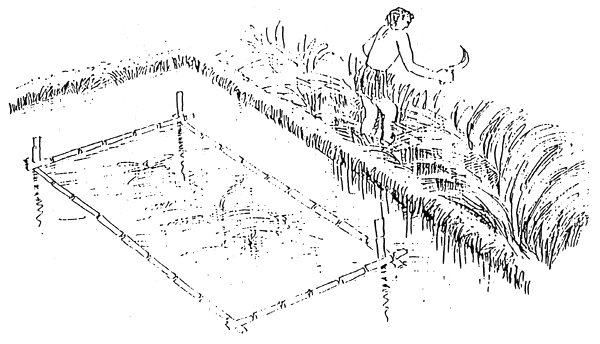
Fig.2.1 Application of grass inside floating bamboo frame
For other species, suggested supplementary daily feeding rate can be 3–5% of estimated body weight of column and bottom feeders.
Feed should be prepared daily. Of the total amount of feed for the day, 50% should be mustard oil cake and 50% should be wheat bran or rice polish. The calculated amount of mustard oil cake should be water soaked overnight then the wheat bran or rice polish should be well mixed with soaked mustard oil cake and shape the feed into balls or pie form. The feed balls are then apply in one or two selected corners of the pond preferably in the morning around 10 a.m.
Storage of feed
The price of feedstuff show seasonal variation. Therefore it is better to buy a larger quantity when the prevalent price is low. However, without proper storage, the nutrient value can deteriorate rapidly. A decomposed, fungal infected feed must not be given to the fish! Feed ingredients should be stored in places which are dry and well ventilated. Feed should be stored always 10–15 cm above the floor level (Fig 2.2).
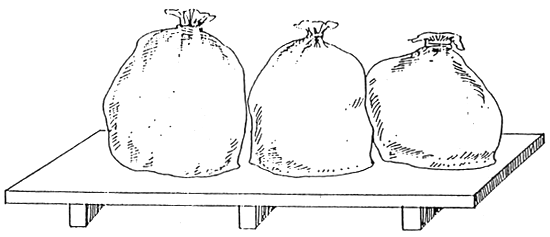
Fig. 2.2 Proper storage of feed stuffs
Pond bottom raking
In order to remove toxic gasses from the pond bottom and overall improvement of pond environment, bottom raking should be done with ‘horra’ (Fig 2.3). Horra is made up of a rope fixed with several sinks. When it is pulled, the sinks hit the surface of pond bottom and help emit toxic gases from the pond. Horra should be pulled 2–3 times a week.

Fig. 2.3 Local made Horra for pond bottom raking
Regular sampling of fish
In a proper fish production management system, periodic sampling at regular interval is very important with a view to
checking the health condition of the fish;
monitoring the growth rate of fish;
calculating the quantity of supplementary feed to be applied in accordance with the increasing biomass of fish.
estimating/survival mortality of fish in the pond
Periodic sampling of fish should be done at least once in a month. In each sampling 10–20 fish of every species should be taken for growth measurement. For sampling, complete netting of pond by seine net is better. However, partial netting of pond also serves the purpose of sampling. Effective partial netting can be done by applying feed at one corner of the pond. The feed attract most of the fish resulting in better catch and sample size.
During each sampling, data relating to fish health and growth rate has to be properly recorded (Format 3).
Any undesirable fish, if some how get into the pond, must be removed if found in the sample netting. In case some fish exhibit the symptoms of any disease, suitable curative measures should be taken immediately. However, prophylactic treatment measure such as giving the fish a dip in potassium permanganate @ 250– 500 ppm/minute should be strictly followed before releasing the fish back in the pond.
Harvesting of fish
Harvesting of fish means the complete removal of fish from the pond at the end of production cycle. A single stocking and a single harvesting are the common practice in existence in Bangladesh. However, like other countries, the technique of partial harvesting and restocking is now being practiced in Bangladesh and has been found to yield better results in terms of fish production per unit area. Under prevailing agroclimatic conditions and proper production management system, some species such as Silver carp, Grass carp, Mirror carp etc. attain marketable size (about 500 g) in 4–5 months of stocking. Bigger size fishes of such species should be harvested and sold in batches and the pond should immediately be restocked with the same number of fishes of such species. Benefits of partial harvesting and stocking are:
allow smaller fish to grow faster
increase carrying capacity of a pond and thus the total production become higher per unit area
farmers get some cash return from the pond within a short period of 4–5 months. This encourages them to reinvest the money in improving his production capacity
all the trophic and spatial niches of the pond are fully utilized throughout the culture period maximizing production
Harvesting of fish is related to biological productivity and carrying capacity of the pond. When the pond is over crowded and the productivity of pond can not support further growth of fish biomass in manure fed pond, relatively bigger sized fishes must be harvested in order to leave available space and food for smaller fish to grow further. Thus, partial or total harvesting of fish can be done at any time when the carrying capacity of a pond is saturated.
Harvesting and marketing of fish in rural areas has to be adjusted in accordance with the market days and demand. Harvesting and marketing of small quantity of fishes by batches would ensure better price in local markets. However, one will also have to consider the cost of harvesting.
Harvesting should be done by seine net preferably in the morning when pond environmental conditions remain good and also ensures better market price of fish. During harvesting, marketable fish should be sorted out first and then small size fish should be returned to the pond. The total operation should be done as quickly as possible so that the fishes returned back to pond are not stressed.
For effective and efficient harvesting of fish from cultured pond, proper nets should be used. Nets presently used are not designed for pond harvesting, and as a result they are not very efficient. Scoop net should also be used in selecting/handling fish. Sketch of a scoop net and seine net with some modifications are suggested through the following illustrations which will help improve harvesting efficiency (Fig.2.4 and 2.5).
Handling of fish
During partial harvesting, the fish that are to be returned to the pond must be handled carefully. What to do and what not to do are listed below :
| Improper | Proper |
| Landing the total catch with net on the bank of the pond to select the fish to be removed | Carefully collect the fish from the net keeping the fish in water |
| Fishes are kept over crowded during the sorting process | Allow more space and do not concentrate too many fish in a small area |
| Surface feeders are retained in the net while other species are selected | First remove silver carp, then catla, grass carp and sarputi, and end with bottom feeder. |
| The fishes which are not selected for marketing are badly handled by throughing one by one in the pond | Allow them to swim out from the net of their own. |
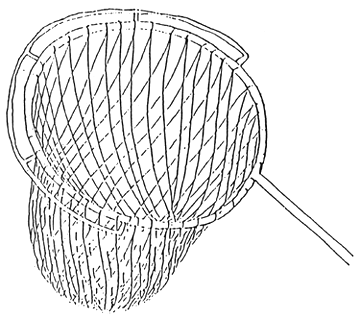
Fig.2.4 Scoop net for easy handling of fish
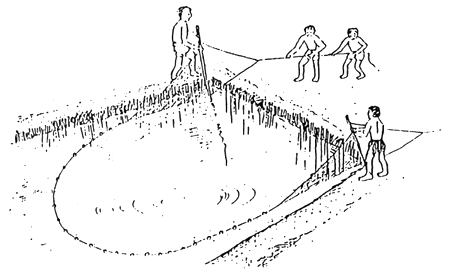
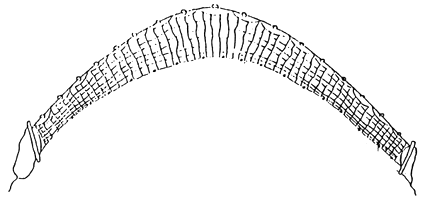
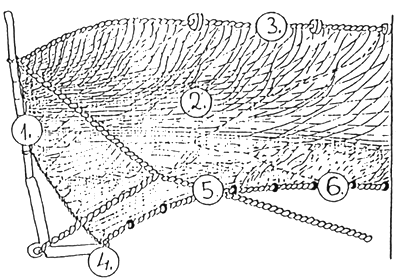
Fig.2.5 Appropriate seine net and netting for pond harvesting
The 1–1.5 inches mesh netting (2) is attached on each side at regular intervals to (1) 5–7 feet wooden poles to form a bag shape. The top of the net is mounted with floats (3) while its bottom part is mounted on a rope with fixed sinkers (not bricks) (6). Two corners are reinforced with steel tubing (4). The seine net is slowly pulled vertically along the pond bottom through two long ropes (5 and top)
Dewatering of pond is the best way of final harvesting though it is not possible regularly as most of the ponds in Bangladesh are undrainable type. Such ponds should be repeatedly netted until the maximum number of fish are harvested. The rest of the stock should be killed by applying suitable fish toxicant.
All harvesting results should be recorded (Record keeping format-4). After the final harvest the total production can be calculated easily from a properly kept recording system.
Fish farmers should be encouraged to maintain proper records of their fish culture operations. The main benefit of a farm record keeping are that --
Such record will provide them with a means of evaluating their performance.
Properly kept records will pinpoint the farmers the causes or factors responsible for their high profit levels or losses in each crop or year. Such information will provide them with a more reliable basis to make decision affecting their farm operations in the future.
These records can be shared with government agencies for formulating policies and development programmes for the development of fish culture in the country.
Essential components of the fish farm record keeping book
(Format: 1–6 enclosed)
FISH FARMERS RECORD KEEPING FORMAT - 1
| BASIC DATA ABOUT THE POND | |
| NAME OF FARMER | : |
| ADDRESS OF FARMER | : |
| TENURE STATUS | : |
FISH POND
Area (in bigha):
Depth (in meter): Maximum: Minimum:
(with seasonal changes)
TYPE OF FISH CULTURE :
(Extensive, semi-intensive, integrated, monoculture, polyculture, etc.)
POND MANAGEMENT
Pond preparation:
| Method of cleaning | : |
| Date of cleaning | : |
| Lime | : |
| Basic manuring | |
Urea | : |
TSP | : |
Organic | : |
Stocking record of fish
| Date | Species | Number | Average weight (g) | Total weight(kg) | Price (Tk.) | |
| 1000 | Total | |||||
| 1. | ||||||
| 2. | ||||||
| 3. | ||||||
| 4. | ||||||
| 5. | ||||||
| 6. | ||||||
| 7. | ||||||
| Total | ||||||
FISH FARMERS RECORD KEEPING FORMAT - 2
MONTHLY FISH PRODUCTION MANAGEMENT RECORD
MONTH: YEAR:
| DATE | L A B O U R E S | FISH FEED | F E R T I L I Z E R | F E E D | CHEMICAL/ MEDICINE | F U E L | OTHERS | DAILY TOTAL TK | |||||||||||||||||||||||
| TYPE OF WORK | HRS | TK | NO | TK | LIME | ORGANIC | UREA | TSP | M.Oil cake | Rice bran | Wheat bran | Blood | Fish meal | Ani.Viscera | |||||||||||||||||
| KG | TK | KG | TK | KG | TK | KG | TK | KG | TK | KG | TK | KG | TK | KG | TK | TK | KG | TK | KG | QTY | TK | QTY | TK | TK | |||||||
| 1 | |||||||||||||||||||||||||||||||
| 2 | |||||||||||||||||||||||||||||||
| 3 | |||||||||||||||||||||||||||||||
| 4 | |||||||||||||||||||||||||||||||
| 5 | |||||||||||||||||||||||||||||||
| 6 | |||||||||||||||||||||||||||||||
| 7 | |||||||||||||||||||||||||||||||
| 8 | |||||||||||||||||||||||||||||||
| 9 | |||||||||||||||||||||||||||||||
| 10 | |||||||||||||||||||||||||||||||
| 11 | |||||||||||||||||||||||||||||||
| 12 | |||||||||||||||||||||||||||||||
| 13 | |||||||||||||||||||||||||||||||
| 14 | |||||||||||||||||||||||||||||||
| 15 | |||||||||||||||||||||||||||||||
| 16 | |||||||||||||||||||||||||||||||
| 17 | |||||||||||||||||||||||||||||||
| 18 | |||||||||||||||||||||||||||||||
| 19 | |||||||||||||||||||||||||||||||
| 20 | |||||||||||||||||||||||||||||||
| … | |||||||||||||||||||||||||||||||
| … | |||||||||||||||||||||||||||||||
| 31 | |||||||||||||||||||||||||||||||
FISH FARMERS RECORD KEEPING FORMAT - 3
SAMPLING RECORD
| Date | Fish Species | Average weight (g) | Estimated | Estimated Biomass | Culture
period (day) | Growth rate (g/day) | ||
| Survival (%) | Number | Kg/pond | Kg/bigha | |||||
| S.CARP | ||||||||
| CATLA | ||||||||
| RUI | ||||||||
| G.CARP | ||||||||
| SARPUTI | ||||||||
| MRIGAL | ||||||||
| M.CARP | ||||||||
| Others | ||||||||
| Total/Average | ||||||||
| S.CARP | ||||||||
| CATLA | ||||||||
| RUI | ||||||||
| G.CARP | ||||||||
| SARPUTI | ||||||||
| MRIGAL | ||||||||
| M.CARP | ||||||||
| Others | ||||||||
| Total/Average | ||||||||
| S.CARP | ||||||||
| CATLA | ||||||||
| RUI | ||||||||
| G.CARP | ||||||||
| SARPUTI | ||||||||
| MRIGAL | ||||||||
| M.CARP | ||||||||
| Others | ||||||||
| Total/Average | ||||||||
| S.CARP | ||||||||
| CATLA | ||||||||
| RUI | ||||||||
| G.CARP | ||||||||
| SARPUTI | ||||||||
| MRIGAL | ||||||||
| M.CARP | ||||||||
| Others | ||||||||
| Total/Average | ||||||||
FISH FARMERS RECORD KEEPING FORMAT - 4
HARVESTING RECORD
FARM NAME:
POND NO: POND AREA:
| Date | Species | Number | Average
weight (g) | Total weight (kg) | Price | Remarks | |
| Tk/kg | Total Tk | ||||||
FISH FARMERS RECORD KEEPING FORMAT - 5
ECONOMIC EVALUATION OF YEAR PRODUCTION PERIOD
| A. | Operating Cost | |||
| Tk. | ||||
| 1. | Dewatering/Poisoning | |||
| 2. | Lime | |||
| 3. | Organic manure | |||
| 4. | Inorganic fertilizer | |||
| 5. | Fish seed | |||
| 6. | Fish feed | |||
| 7. | Labour (cash/kind) | |||
| 8. | Pond rental | |||
| 9. | Miscellaneous | |||
| 10. | Interest on operating capital | |||
| Total Expenses (Tk.) | ||||
| B. | Sale Income | |||
| 1. | Revenue from the sale of fish | |||
| 4. | Value of fish consumed at home | |||
| 5. | Value of fish pond in kind | |||
| 6. | Other revenues incidental to production | |||
| Total Sale Income (Tk.) | ||||
C. Net Income = Total Sale Income - Total Expenses (Tk.) | ||||
FISH FARMERS RECORD KEEPING FORMAT - 6
PERFORMANCE INDICES
Production costs of fish per kg :
Production per bigha/year: 
Net income = Total sale income - Total operating cost
Net income per bigha of fishpond = 
Net income per kg of product =
Percentage return on operating cost = 